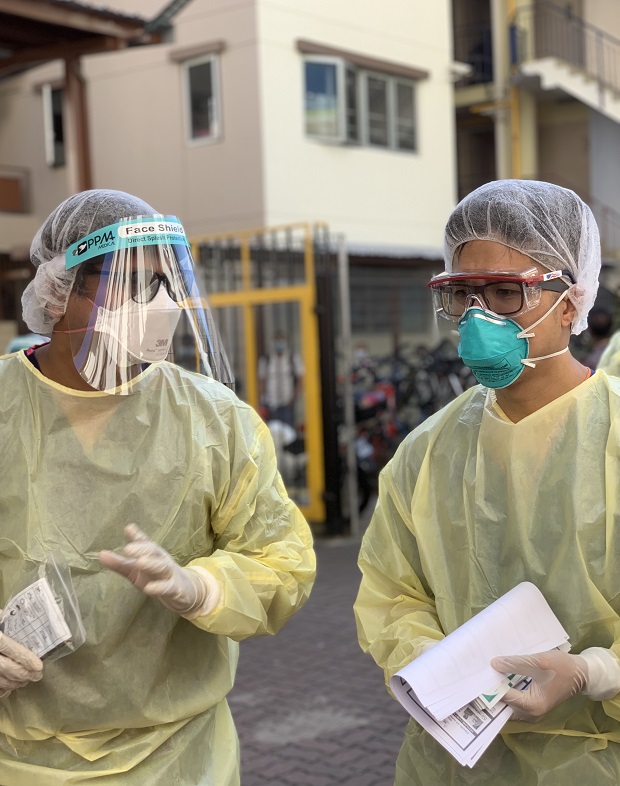<<Healthcare workers who cared for migrant workers during the COVID-19 pandemic looked beyond the latter’s clinical needs, and catered to their mental and emotional well-being. Photo: Chin Lee Lian>>
For migrant workers, being diagnosed with COVID-19 in a foreign land triggered a cascade of emotions, from fear to anxiety. The uncertainties surrounding the virus, where and how they will receive care, and the financial impact they may experience weighed heavily on their minds.
“Many asked about the trajectory and complications of their diagnosis — information that was not easily available at the time. Others were visibly worried and concerned about their lives and livelihoods,” said Dr Dennis Chia, Consultant, Emergency Medicine, Sengkang General Hospital (SKH).

<<Dr Dennis Chia (right) was
part of SKH’s mobile medical
team that served migrant
workers in the dormitories
during the early days of
the pandemic.>>
Dr Chia was part of SKH’s mobile medical team that served migrant workers in the dormitories during the early days of the pandemic. The experience prompted him to collaborate with a couple of likeminded peers to set up the Holistic response and Outreach Team (HOT), which looked beyond migrant workers’ clinical needs to offer psychological and social support.
Such psychosocial support was also crucial in hospitals, where COVID-19 patients, many of whom were migrant workers, were isolated during their care.
“The main focus when we learnt of the need and extent of isolation was mentally preparing the patients for what was to come, and to provide them with the skills needed to handle the fear and anxiety about the pandemic, as well as how to cope with being cooped up in isolation,” said Dr Evelyn Boon, Head, Psychology, Singapore General Hospital (SGH), who implemented several interventions to engage COVID-19 patients in SGH’s isolation wards.
One example was the use of an Art Therapy kit, which contained art supplies and a colouring activity book with guiding questions, for patients to engage in personal reflection during their recovery journey. The team also started weekly virtual patient support group sessions to check in on patients’ mental well-being, address their concerns and feedback, and to connect them with other patients.
Language barriers
“One of our challenges was not being able to speak the workers’ native language,” said Dr Chia.
Dr Lee Guozhang, Consultant, Department of Internal Medicine, SGH, who ran the hospital’s isolation wards for COVID-19 patients, experienced similar challenges.
“The fear and anxiety that the migrant workers were already experiencing as a result of their COVID-19 diagnosis were further heightened by the language constraints. The difficulty in documenting clinical history and communicating the care plan to the patients was immediately apparent, and I knew we needed to adapt to the differing needs of this group of patients,” he said.
To overcome this, multilingual education resources with information on COVID-19, patients’ hospital stay, and mental health were distributed across SingHealth’s hospitals to help patients better understand what they were going through and manage their expectations of the recovery journey.
“We recruited volunteers and healthcare workers across SingHealth who spoke Bengali, Burmese, and Tamil to co-facilitate the virtual patient support group sessions. It helped us understand the different cultural contexts and beliefs to better engage with the patients,” said Dr Boon of the COVID-19 support group sessions, which turned out to be very popular among the migrant workers.
Renewed purpose
Despite all the challenges, treating COVID-19 patients, specifically the migrant workers, has renewed the medical team’s sense of purpose.
Aside from witnessing the workers’ resilience and grit, Dr Chia was very moved by the strong camaraderie and brotherhood among the workers.
“Even in the face of danger and uncertainty, they maintained their demeanour. Older peers comforted their juniors when they shared their concerns and fears. They have braved hardships to work in Singapore — leaving their loved ones to come here at a young age, and engage in labour-intensive work. Through them, we hear stories of resilience, tenacity, and hope; stories that offer a different perspective of Singapore,” he said.
For Dr Boon, the experience showed her the essence of true gratitude, and reaffirmed her belief of the need to always consider the patient’s perspective, as well as her passion to serve them.
“I am honoured to be able to play a part in alleviating their fear. This has also reiterated the importance of the human touch in medicine. Reassuring words that express our understanding of their fears and anxiety can offer a lot of comfort and help with the healing process,” she added.
Dr Lee saw the importance of contextualising psychosocial interventions to meet the socioeconomic, cultural, and spiritual needs of patients.
“Working with a diverse team of healthcare workers from different cultural backgrounds has allowed us to better understand and address some of the issues faced by the migrant workers. It is crucial to engage various groups and stakeholders who have greater insight into unique socio-cultural considerations to offer informed interventions,” Dr Lee said.
“To cure sometimes, to relieve often, and to comfort always” is a mantra that Dr Lee picked up during his medical-training days, and fell back on throughout the COVID-19 period. He made it a point to greet the workers in their native language during the morning rounds, and often they would break into a smile.
“This experience has reminded me of the privilege to be able to care for our patients,” he said.
